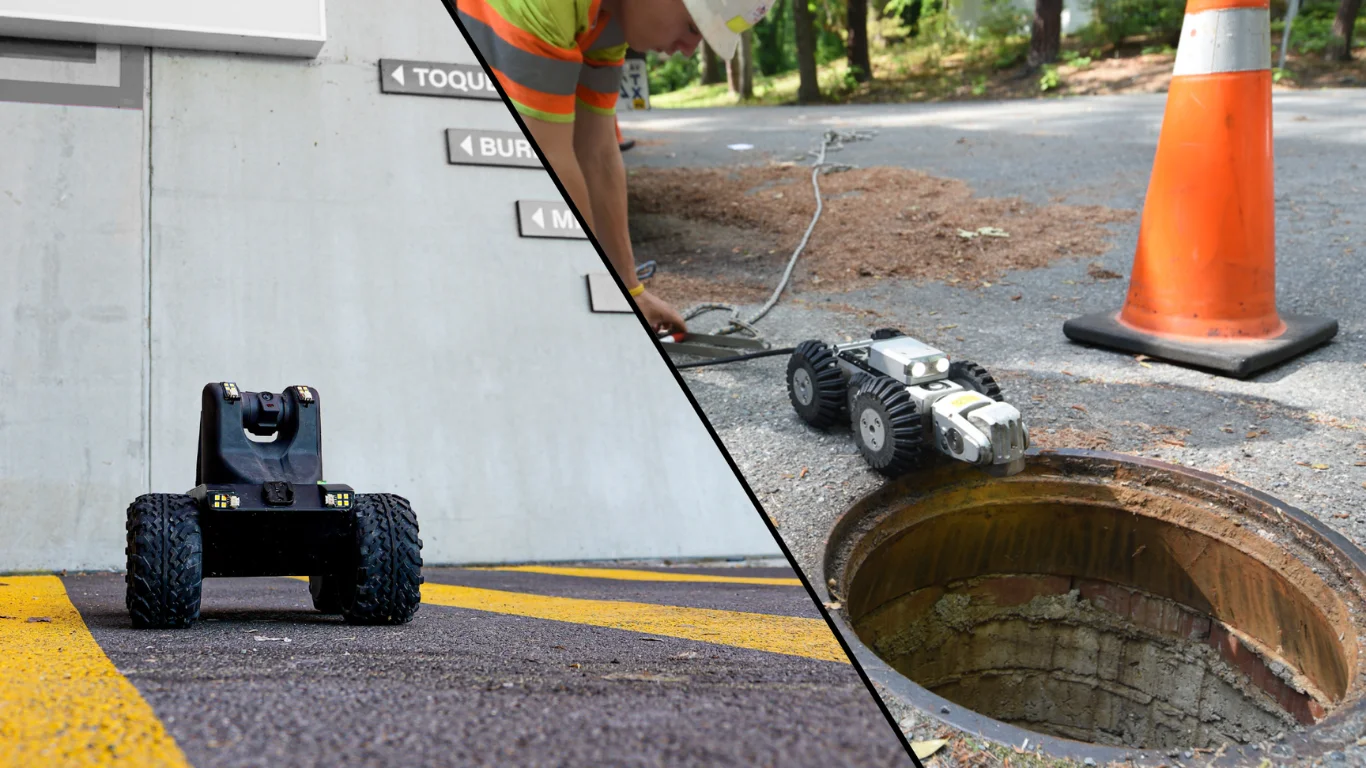Television inspection plays a crucial role in many industries, including monitoring underground infrastructure, inspecting industrial ducts, and assessing facilities in confined spaces. With the evolution of technology, the choice between a wireless or wired television inspection (TVI) robot has become a central question. In this article, we will examine the specificities of these two technologies and the criteria for making the best choice.
What is a TV inspection robot?
A televisual inspection robot (TVI) is a device designed to visually assess hard-to-reach spaces. It is commonly used in pipelines, industrial conduits, subsea installations, or confined environments such as tanks or reservoirs.
Equipped with high-definition cameras, sometimes up to 4K, and powerful LED projectors, this robot can capture precise images, even in low-light conditions. Its role goes far beyond a simple visual inspection: it is often used to detect cracks, degradation or obstructions that could compromise the safety or efficiency of infrastructures.
Wireless ITV Robot: Advantages and Applications
Wireless ITV robots, such as Multinnov ’s Roview2 , represent a significant advancement in the field of industrial inspections. These devices are equipped with technologies that allow them to operate autonomously, without relying on a cable to transmit data or power.
Benefits of Wireless ITV Robots
• Increased mobility: Without the constraints of a cable, these robots can move freely in complex environments. This is particularly useful in pipes or conduits where tight corners and obstacles make it difficult to use a cable.
• Extended range: The range of a wireless robot depends mainly on the quality of its signal. In confined spaces, materials such as metal can facilitate signal transmission, allowing the robot to travel significant distances.
• Ease of deployment: With no wires to connect or manage, these robots can be quickly deployed, reducing lead times and simplifying their use, especially during emergency response.
Typical applications
Wireless robots are particularly suitable for confined environments where autonomy and flexibility are essential. They are used in:
• Underground industrial conduits.
• Tanks and reservoirs where access is limited.
• Inspections of metal structures, where signal transmission is optimized.
With robust performance, the Roview2 perfectly illustrates these advantages, combining mobility, precision and technological innovation.
Wired ITV robot: applications and limits
In contrast, wired ITV robots remain a popular option, particularly in environments where signal stability is essential.
Typical applications of wired robots
• Complex signal environments: In environments where materials absorb or block signals, such as thick concrete structures, a wired robot ensures stable data transmission.
• Long-distance inspection: Some wired ITV robots can cover greater distances than wireless models, thanks to a dedicated power and transmission cable.
• Extended use: Unlike cordless models, corded robots are not limited by their battery life, making them ideal for long or complex inspections.
Limitations of wired ITV robots
However, these devices have drawbacks:
• Restricted mobility: The cable can be cumbersome in narrow or obstructed spaces.
• Risk of cable damage: In abrasive environments, the cable may become worn or damaged.
• More complex installation: Deploying a wired robot requires more time and organization.
Choosing between a cordless or corded ITV robot
Choosing between a cordless ITV robot and a corded model depends on several factors. Here are the main criteria to consider:
Inspection environment
• Metallic or open environments: Wireless robots, such as the Roview2 , are perfectly suited to these environments, thanks to their excellent signal transmission.
• Concrete or complex environments: Wired models are preferable in structures that block or absorb the signal.
Distance to travel
• For inspections over short distances (less than 200 meters), wireless robots are effective.
• For inspections beyond this range, tethered robots offer more stability and autonomy.
Complexity of the task
• For rapid inspections or in changing environments, wireless robots allow for greater flexibility.
• For long inspections or those requiring continuous power, a wired robot will be more appropriate.
Logistical constraints
• If time or resources are limited, a wireless robot is easier to deploy.
• For abrasive or hazardous environments, wired robots require robust cables and extra precautions.
Multinnov solutions for your industrial inspections
Multinnov stands out for its constant commitment to innovation in television inspection technologies. Specializing in wireless solutions such as the Roview2 , the company offers tools designed to meet the specific challenges of inspections in confined spaces. With a focus on reliable performance and ease of use, Multinnov supports professionals in their most demanding projects. Its priority is to offer solutions adapted to the needs of each industry, taking into account the unique constraints of each environment.
Choosing between a wireless or wired TV inspection robot is based on a thorough analysis of your needs and the constraints of your environment. While wireless models, such as the Roview2 , offer unmatched mobility and flexibility, wired robots guarantee increased stability and autonomy for more complex tasks.
With Multinnov , you have access to innovative and tailored solutions, designed to meet the requirements of modern industry. Whether it is inspections in confined spaces or long distances, their products are up to the most demanding industrial challenges.


